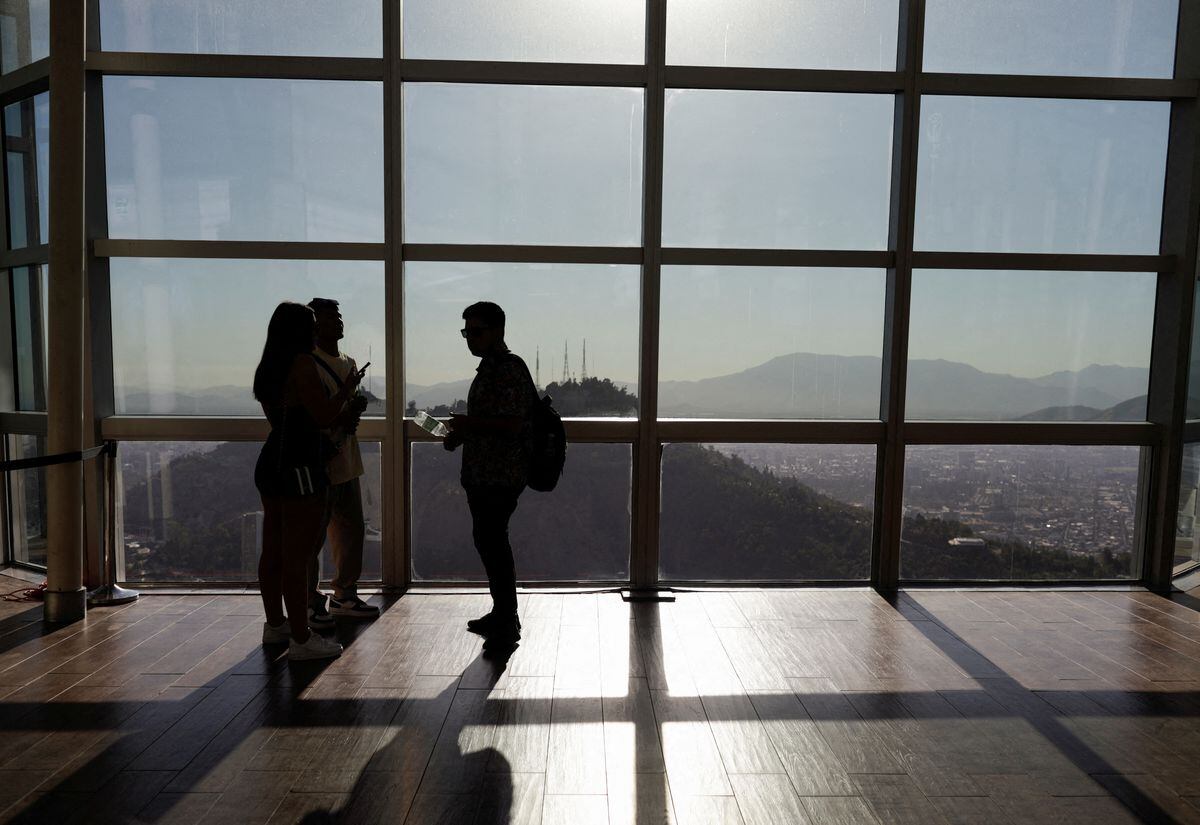Enlarge image
Smog over the city of Santiago de Chile
Photo:
CLAUDIO REYES / AFP
It's getting hotter and hotter and more and more often - the Chilean capital Santiago de Chile is also struggling with this problem.
In March, the regional government therefore appointed Cristina Huidobro Tornvall as extreme heat officer.
Huidobro is one of five official Chief Heat Officers worldwide, supported by the Arsht Rockefeller Foundation.
The others work in Athens, Greece, Miami in the USA, Monterrey in Mexico and Freetown in Sierra Leone.
They should prepare their cities for climate change and draw up emergency plans to protect particularly vulnerable people from extreme heat - from a silent killer that is claiming more and more lives around the world.
Huidobro Tornvall is the first of its kind in Latin America.
She was appointed at the same time as progressive Gabriel Boric, 36, who won the presidential election with a feminist and green agenda, took office - a chance for the country to tackle the already pressing problems caused by the climate crisis, such as the years of severe water shortages.
SPIEGEL:
How hot will it be in Santiago de Chile?
Huidobro Tornvall:
Not as hot as Seville in Spain or New Delhi, the Indian capital.
But a heat wave is not about a specific temperature, like, from 40 degrees Celsius we have a wave, but heat is related to the average temperatures in a region.
For example, we had a heat wave in the Arctic this year.
It was 18 degrees there, but that's extremely high because the temperatures are supposed to be below zero there.
Extreme heat is relative.
SPIEGEL
: How has the climate in Chile changed?
Huidobro Tornvall:
We weren't prepared here for it to get so hot so quickly.
We actually have a Mediterranean climate.
When it got to 30 degrees in summer, that was considered hot.
Now we have temperatures of 32, 34, 35 degrees every summer.
These two to five degrees are a lot - for the citizens, the environment, for our cities that are not prepared.
We've had nine heat waves a year across Chile in the past.
Now there are 62. In addition, we have been experiencing a severe drought for 13 years.
SPIEGEL:
What measures are you planning as Chief Heat Officer?
Huidobro Tornvall:
We have to make our city fit for what's to come.
Because it won't get any better, only more extreme.
We have set up a task force to monitor temperatures and take immediate action if a heat wave threatens.
We have experience with an emergency system called "code blue" - it comes into effect when it gets extremely cold or about five degrees and hail is expected.
Then people are taken off the streets and taken to shelters.
Families living in risk situations that are particularly vulnerable are evacuated.
We distribute food and warm clothing.
We can now use this experience to develop our »code red« system – an emergency plan for heat waves.
SPIEGEL:
You are an architect and urban planner.
Is it also about structural changes in Santiago de Chile?
Huidobro Tornvall:
Yes.
And it's exciting for me to develop a city for the future, to adapt it to climate change and extreme heat.
First and foremost, we need to address urban heat islands.
SPIEGEL:
What are urban heat islands?
Huidobro Tornvall:
If you measure the temperature in a city, then there are differences.
They are between one and five degrees - in the same city, on the same day, at the same time.
That has nothing to do with the climate, but with the special environmental conditions at a location, the buildings, the infrastructure.
So it may well be that you measure 28 degrees in a rich, green part of the city – and 32 degrees in a poor neighborhood that is densely populated, where there are no parks and problematic materials were used to construct houses.
This is what we call an urban heat island: elevated temperatures in certain locations in the city.
SPIEGEL:
And how do you intend to deal with these islands?
Huidobro Tornvall:
We have to
Build social housing from materials that reflect heat rather than absorb it.
In the poor areas, the houses have corrugated iron roofs, fatal in the heat.
We have a project using specially developed white paint to paint these roofs - a simple and cheap way to bring relief to poor families.
Of course we would like to have green roofs everywhere, but that is an ideal.
The cheaply constructed houses cannot bear green roofs at all.
SPIEGEL:
But green roofs should also play a role in the transformation of Santiago de Chile.
Huidobro Tornvall:
We are initially planning the following pilot project, which should start in September: A public hospital in the gray city center should have a green roof and green terraces.
The aim is, on the one hand, to reduce temperatures and save energy, but also to improve mental health.
The people who work in the health system and the patients can then look out onto the greenery from the windows.
SPIEGEL:
Which plants would you like to plant there?
Palm trees?
Eucalyptus?
Huidobro Tornvall:
Of course you can't just plant whatever you want.
For example, eucalyptus is a very bad option.
The plant comes from Australia and we have a lot of eucalyptus trees here that use a lot of water.
Either native species must be planted, or those that have been adapted to climate change.
Succulents are good too.
They store CO₂, use very little water and are easy to care for.
We will establish a typology of suitable plants.
SPIEGEL:
However, a green roof will hardly affect the overall situation in the city.
Huidobro Tornvall:
No, we want green roofs to spread all over the city as quickly as possible.
To this end, we would like to get the central government on board in addition to the local government, as well as international donors and private companies.
The latter have recently found green roofs great, often more for marketing reasons.
We also plan to plant more trees in public spaces, as part of a massive planting specifically aimed at urban heat islands.
We already have two million dollars ready for it.
Here, too, we are looking for the right trees.
It's not that easy: they have to be suitable for public spaces, which means they have to grow quickly, the crown has to be high enough and they mustn't produce too many allergens.
Peumo and Belloto del Norte are now possible,
SPIEGEL:
Do you also want to reduce emissions in the city as part of your future strategy?
Huidobro Tornvall:
Another of our pilot projects aims to do just that.
Road traffic produces the most emissions.
We want to turn Santiago de Chile into a city where people would rather ride their bikes than get in their cars.
We are currently designing an ambitious network with more than 1000 kilometers of cycle paths.
We'll start with the main street of Santiago, it's called Alameda.
That's a big challenge, two million people travel there every day.
This so-called metropolitan line will have 24 kilometers and is currently being examined by the Ministry of Transport.
We must finally think of cycle paths as part of the infrastructure - and not as a leisure activity.
SPIEGEL:
One of the biggest problems in Chile is the water shortage.
Is water also part of your area of responsibility?
Huidobro Tornvall:
Yes.
Our rainfall is well below historical averages, our supplies are at risk.
We exchange ideas with other cities around the world.
There is an international network that develops methods for dealing with water.
With the so-called Water Fund, we have established a partnership of public institutions and private companies to secure the future of our water supply.
We want to use campaigns to make it clear to people that we have a water shortage - even though water is still coming out of the tap.
Many do not take the problem seriously enough.
But there is also an emergency protocol for rationing water if necessary.
SPIEGEL:
Water has been privatized in Chile. Does that contribute to the problem?
Huidobro Tornvall:
The problem is not so much who owns the water as how it is managed.
It takes good, efficient water management.
Nevertheless, in Chile we are currently discussing the question of who should own water as part of our new constitution.
SPIEGEL:
In France, the water supply system has collapsed in many communities at the moment, and water is being delivered by truck.
Does this also happen in Chile?
Huidobro Tornvall:
We know that well.
In the city, the drought is less noticeable.
But there are big problems in the Santiago de Chile region.
Rural people have regional water supply systems.
The groundwater is fetched from the ground with pumps, stored in a tank and passed on to households.
However, less and less groundwater is available.
Therefore, the city must supply water to the rural communities.
Trucks come to fill the tanks.
SPIEGEL:
Where does the city get its water from?
Huidobro Tornvall:
Our water comes from the Andes.
We have big rivers and reservoirs.
Unfortunately, the rivers are getting thinner and shallower.
Not only is the snow melting, but our numerous glaciers are melting as well.
This is dramatic, because they are our last freshwater reservoir.
The combination of drought and heat is fatal.
The safety of our water supply is definitely at risk.
I hope that the heatwaves will at least make people around the world finally wake up and take climate change more seriously.
This contribution is part of the Global Society project
Expand areaWhat is the Global Society project?
Under the title "Global Society", reporters from
Asia, Africa, Latin America and Europe
report on injustices in a globalized world, socio-political challenges and sustainable development.
The reports, analyses, photo series, videos and podcasts appear in a separate section in SPIEGEL's international section.
The project is long-term and is supported by the Bill & Melinda Gates Foundation (BMGF).
A detailed FAQ with questions and answers about the project can be found here.
AreaWhat does the funding look like in concrete terms?open
The Bill & Melinda Gates Foundation (BMGF) has been supporting the project since 2019 for an initial period of three years with a total of around 2.3 million euros - around 760,000 euros per year.
In 2021, the project was extended by almost three and a half years until spring 2025 under the same conditions.
AreaIs the journalistic content independent of the foundation?open
Yes.
The editorial content is created without the influence of the Gates Foundation.
AreaDo other media also have similar projects?open
Yes.
With the support of the Gates Foundation, major European media outlets such as The Guardian and El País have set up similar sections on their news sites with Global Development and Planeta Futuro respectively.
Did SPIEGEL already have similar projects? open
In recent years, SPIEGEL has already implemented two projects with the European Journalism Center (EJC) and the support of the Bill & Melinda Gates Foundation: the "OverMorgen Expedition" on global sustainability goals and the journalistic refugee project "The New Arrivals ", within the framework of which several award-winning multimedia reports on the topics of migration and flight have been created.
Expand areaWhere can I find all publications on the Global Society?
The pieces can be found at SPIEGEL on the Global Society topic page.





/cloudfront-eu-central-1.images.arcpublishing.com/prisa/XTSAGQZPYBGJZPC7MCRBBZLC7E.jpg)





/cloudfront-eu-central-1.images.arcpublishing.com/prisa/KMEYMJKESBAZBE4MRBAM4TGHIQ.jpg)



